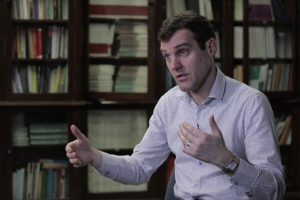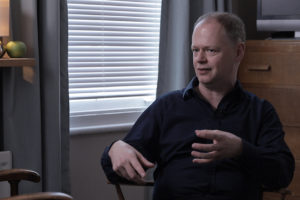Tropical Cyclone
Meteorologist Chris Brierley on the tropical cyclogenesis, the distribution of tropical cyclones on the planet...
We know that we have a challenge at the moment in health care in the UK and I think in many other countries as well. That’s the health care is seen as the point of call for problems. But as a result of this apparently we find that between a third and a half of all visits to doctors are actually for non-medical reasons that are broader issues: for example, feeling lonely or socially isolated, low level mental health problems or other issues in people’s lives that might well be translating into health issues but actually at their root cause are not medical. Because of this there’s this recognize resource drain that’s occurring and this pressure people put on health services.
So there’s been interest in the last few years on something called social prescribing. The idea is that if somebody comes to their doctor with a problem that actually might not be getting the right solution could they be referred to other services that might be able to provide better supports? This has a couple of benefits. First of all, it might provide better support for the patients themselves, people who keep going back to their doctor not being able to find a solution, might become frustrated and it also might lead them to feel that they’re not being considered as a whole person in their own rights.
But equally it can also reduce pressure for doctors. Doctors have very short consultation times with each patient. Also the cost of these unnecessary visits in some analyses is thought to be equivalent at the salaries of nearly four thousand doctors every year. So the way that social prescribing works is that if somebody goes to the doctor and the doctor thinks – well, what you’ve come to me with isn’t something that I can solve in a medical way – the doctor can write a prescription to this patient: go and see somebody called a link worker or navigator. The link worker’s role is to know all of the activities that exist in the local community, for example, gardening clubs, arts classes, book groups, other types of social activities, choirs and the idea of this link worker is to spend much more time with the patient, be able to talk to them properly, to find out what their needs are. Could their needs be supported by some kind of community, social activity and if so, what kind of activity is the person going to want to go to? What’s actually going to meet their needs and also their enjoyment?
In some cases it might be the case that this link worker is merely able to refer somebody onto an existing program. In other cases they might need a slightly closer contact, they might need to actually pass them over to an individual who’s going to help them and introduce to a new activity. They might be checking up on them on a regular basis. Or for some it could be there’s a really specific activity that’s probably going to have more benefit than others and therefore there’s a more targeted prescription to that activity. So to give an example of some of the programs that exist there’s a wonderful program called ‘Green gym’ which is all about helping conservation and volunteering, to be something that people can use for their own health and well-being.
So people take part in activities like fixing fences, helping with the cleaning of ponds, helping with the developments of new gardens and conservation areas. Through the process of this they’re meeting more people in the community and they’re also doing something that could benefit their mental health. ‘Green Gym’ has worked in partnership with a charity called ‘Mind’ which is a mental health charity. So it’s a very well informed programming that actually understands the needs of many of the people who might be coming onto it. Another example is called ‘Arts and minds’, this is run around the Cambridgeshire area and this is arts program for people to help their mental health. Again, this is very carefully constructed, all the sessions have artists and also have counselors in the room, so they’ve got this dual supports.
There’s the recognition that the arts classes might be able to offer something that could really help this person, their mental health. So what are these things that could actually be helped by these activities? What are these magical ingredients? The idea behind some prescription is this arts activities are what we call multimodal activities, they combine multiple different factors that we know are beneficial health. For example, they give a chance for emotional expression, they might be stress reducing, they’re of calming or relaxing nature, they might provide a social support, they might introduce people to new people, so they feel less lonely in their areas, they might be providing cognitive stimulation, it might be helping with skills development so people learn new skills, have got new employability options as well. They might be helping with broader social capital and social cohesion within communities.
So all of these different factors together can start to add up to have an effect on health. What’s particularly good about arts and creative activities in providing all of these different components is that they’ve got an inherent motivation to engage. People often want to do these as fun hobbies as well. So this can actually be an added incentive for people to actually take part and regularly go to these sessions.
Let’s consider a patient who actually went through this. I met this guy called Russell a few years ago and Russell said that he’d initially been going to his doctor because he suffered a very serious stroke and following the stroke he actually developed depression. He wasn’t able to work or provide his family and he said this was really difficult for him to cope with. Because of this he was feeling very low in self-esteem, he had a number of other symptoms that started to develop, for example, difficulty in sleeping. So as a result he was going back to the doctor trying to get solutions to this and he was offered a number of medical solutions, medications, things to help with sleep, with anxiety, but these really weren’t solving what his issues were and he said eventually his doctor offered him a program called ‘Art lift’. Initially he said he was very reticent, he didn’t want to go along, he thought it was going to be a room full of people hugging each other. But he said he went along to the first session just to see and he was actually amazed, he really enjoyed it, he really enjoyed painting, something he hadn’t really done before. So he started going back and actually over a period of weeks he started to see benefits: he was no longer needing help with his sleep, he was with his doctor, he was gradually able to reduce the medication that he was on, so he was off it completely.
He actually starts to develop new skills, a real sense of pride and achievement. In fact he discovered a real talent for painting and actually started being commissioned to do exhibitions of his work. He’s also now running his own sessions in the community for other people who’ve had similar mental health problems or physical challenges and actually helping them to learn the same skills he has to take part in the same kinds of programs that he was referred to. So it’s been this wonderful virtual cycle back to him now supporting exactly the same type of people that he was a few years ago.
So a natural question for all of this is, well, there’s the money come from? So a number of these arts on prescription programs are actually paid for by arts organizations or philanthropists, charities or lottery funds. Some of them actually though are being paid for by the healthcare system in the UK. What’s being found is that some areas in the healthcare sector are quite keen to pay because these programs have actually been shown to reduce some of the costs for healthcare. For example, it’s been found that for every pound that gets spent on link workers up to four pounds is being saved; in fact, possibly somewhere between 4 and 11 pounds from some studies is being saved in terms of reductions in unnecessary medication prescriptions or reductions in the number of visits to doctors.
And as well as this we’re also seeing wider benefits for the health sector, for example, we know that there can be a very long waiting lists for people to get psychological therapies whereas in fact ‘Arts and minds’, the program I mentioned in Cambridgeshire, can refer people in 48 hours. We also find that there are other areas of repeat visits that can be supported. There was a pilot project they ran in Croydon where they particularly looked at admissions to hospital and use of other healthcare services. I found a 20% reduction in this for people who taken part in arts programs on prescription.
As we’re looking forward to what’s happening next we can already see that there are hundreds of general practices, doctors, surgeries around the UK that are already taking part in arts on prescription and also the broader scheme of social prescribing. But we’re actually starting to see that there are some that are getting incredibly committed. For example, in Tower Hamlets they have an over 90% of their GP practices are engaged in this and 98% of the doctors, the GPs, who prescribed or reported benefits for that patients. So partly in light of this we had announcements from NHS England that they’re now going to be rolling out wider support for social prescribing and this includes funding a thousand new link workers through work at doctors surgeries around the UK to be able to refer people through to these programs to help with their health.
So overall I think what’s particularly promising about arts on prescription isn’t just about the benefits that we’re getting in terms of helping the health sector but it’s also about the individual benefits that we’re seeing here. For patients who before might have been feeling they weren’t having all of their needs met we’ve now got the option. This can be added in as another option within their treatments. Also what this provides is looking at the person as a whole person, considering every aspect of their lives that might require supports. I think this is very comforting to patients because it could feel that they’re actually being really listened to and that people are actually really keen to help them. It also provides a very nice joined-up working between health sector, social sector and also the arts, voluntary and community sectors as well. Perhaps, this is the way we should be considering healthcare more, in terms of not just seeing it as the responsibility of the health sector but seeing it as something that multiple other bodies can all support and bringing their own skills, their expertise, their programs together to make sure that we’ve got multiple options to help the multiple different aspects of people’s health.

Meteorologist Chris Brierley on the tropical cyclogenesis, the distribution of tropical cyclones on the planet...

Neuropsychologist Barbara Sahakian on episodic memory, the symptoms of schizophrenia, and the drugs used in Al...

Linguist David Adger on the Facebook chatbots experiment, the history of getting the AI to understand and spea...